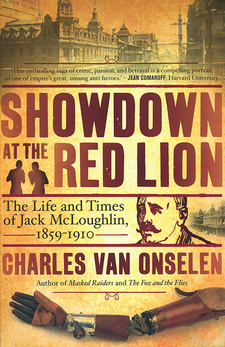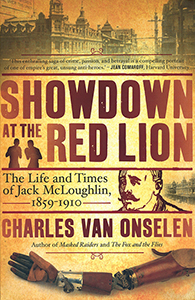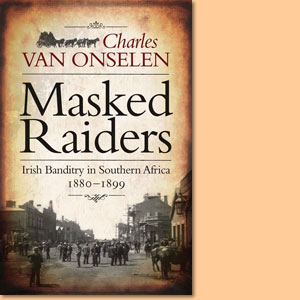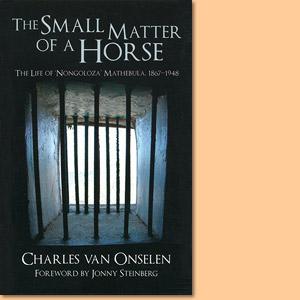Showdown at the Red Lion: The Life and Times of Jack McLoughlin 1859-1910, by Charles van Onselen

Showdown at the Red Lion: The Life and Times of Jack McLoughlin 1859-1910, by Charles van Onselen. Jonathan Ball Publishers. Johannesburg; Cape Town, South Africa 2015. ISBN 9781868426225 / ISBN 978-1-86842-622-5
Charles van Onselen has long been acknowledged as among the finest of contemporary social historians. But 'Showdown at the Red Lion: The Life and Times of Jack McLoughlin 1859-1910' will add to his reputation in a major way.Through the painstaking archival detection that is the hallmark of his work, he has traced the global career of an intriguing late 19th and early 20th century career criminal and murderer.
JOHANNESBURG AND PRETORIA 1891-1892
In a real dark night of the soul it is always three o'clock in the morning, day after day. Scott Fitzgerald
The events at Potchefstroom and the loss of his hand a few months later were a life-changing episode, one so intense that it is impossible to do justice to it. It produced a prolonged crisis - arguably, one without end - that affected every facet of the hidden ideologies and patterns of thinking that had shaped McLoughlin's behaviour up to that point and beyond. It altered the ways in which he saw himself and his newly asymmetrical body and it changed the ways in which he saw others. For months, possibly years, strange aching sensations reminded him that his body and mind were locked into an immutable arrangement: pain, that could only be relieved by the cheapest analgesic of the age. And, when his body and mind eventually arrived at a settlement, they refined the ways in which he was capable of loving someone, or of being loved. In the absence of a diary, personal correspondence or reliable accounts from anyone close to him there is no easy way of telling what scars the journey to accommodation, rediscovery and reconstruction left him with. Seemingly trivial things could easily have cut as deeply as serious ones. j-[0w could a man raised in a cult of masculinity that prized notions of honour, loyalty and physical prowess still function on the frontiers of empire vvith only one arm? More prosaically, how were such noble values to be reconciled with the fact that he could not readily button a shirt, cut meat, pull up his breeches or tie his bootlaces? He had never aspired to being a model citizen, but how was he to fund the life he had become accustomed to? How was a man who relied on picking locks and pockets, lifting catches and forcing latches for his living, let alone moving and blowing up safes, to go about his business? Was he still a man - and, if so, what sort of man, and by whose definition? Pain prised open old fault-lines of character and behaviour, leaving him more impulsive and irascible. Between 60 and 80 per cent of all amputees experience impulses emanating from so-called 'phantom limbs' for periods whose onset or end cannot be predicted. Discomfort arising from aching, burning or tingling sensations is among the relatively minor symptoms experienced by those who have lost limbs. Others - and more especially those who have lost arms rather than legs - often have to live with the feeling that missing parts have been truncated, or placed in awkward or unnatural positions. Although only 'imagined' by the brain via its disrupted nervous system, the victim nevertheless genuinely experiences acute, chronic pain. In Johannesburg, men without limbs were not an unfamiliar sight in the 1890s. As the diggings gave way to deep-level mining the usual mishaps with industrial machinery and accidents attributed to unstable dynamite meant that the loss of a limb was hardly a novelty. Although always disastrous for the individual concerned, the ways in which amputees were dealt with varied according to the craft-skill and social standing of the victim. [...]
This is an excerpt from the biography Showdown at the Red Lion: The Life and Times of Jack McLoughlin 1859-1910, by Charles van Onselen.
Title: Showdown at the Red Lion
Subtitle: The Life and Times of Jack McLoughlin 1859-1910
Author: Charles van Onselen
Genre: Biography
Publisher: Jonathan Ball Publishers
Johannesburg; Cape Town, South Africa 2015
ISBN 9781868426225 / ISBN 978-1-86842-622-5
Softcover, 16 x 24 cm, 515 pages, several b/w photographs
van Onselen, Charles im Namibiana-Buchangebot
Showdown at the Red Lion: The Life and Times of Jack McLoughlin 1859-1910
Showdown at the Red Lion traces the global career, the life and times of the criminal and murderer Jack McLoughlin (1859-1910) in South Africa.
Masked Raiders. Irish Banditry in Southern Africa 1880-1899
Masked Raiders: Irish Banditry in Southern Africa 1880-1899" tells the tale of history where Irish troops deserted their posts for the allure of the diamonds and gold.
The Small Matter of a Horse: The Life of Nongoloza Mathebula
The small matter of a horse: The life of Nongoloza Mathebula 1867–1948 tells how a young man became a hardened criminal.



